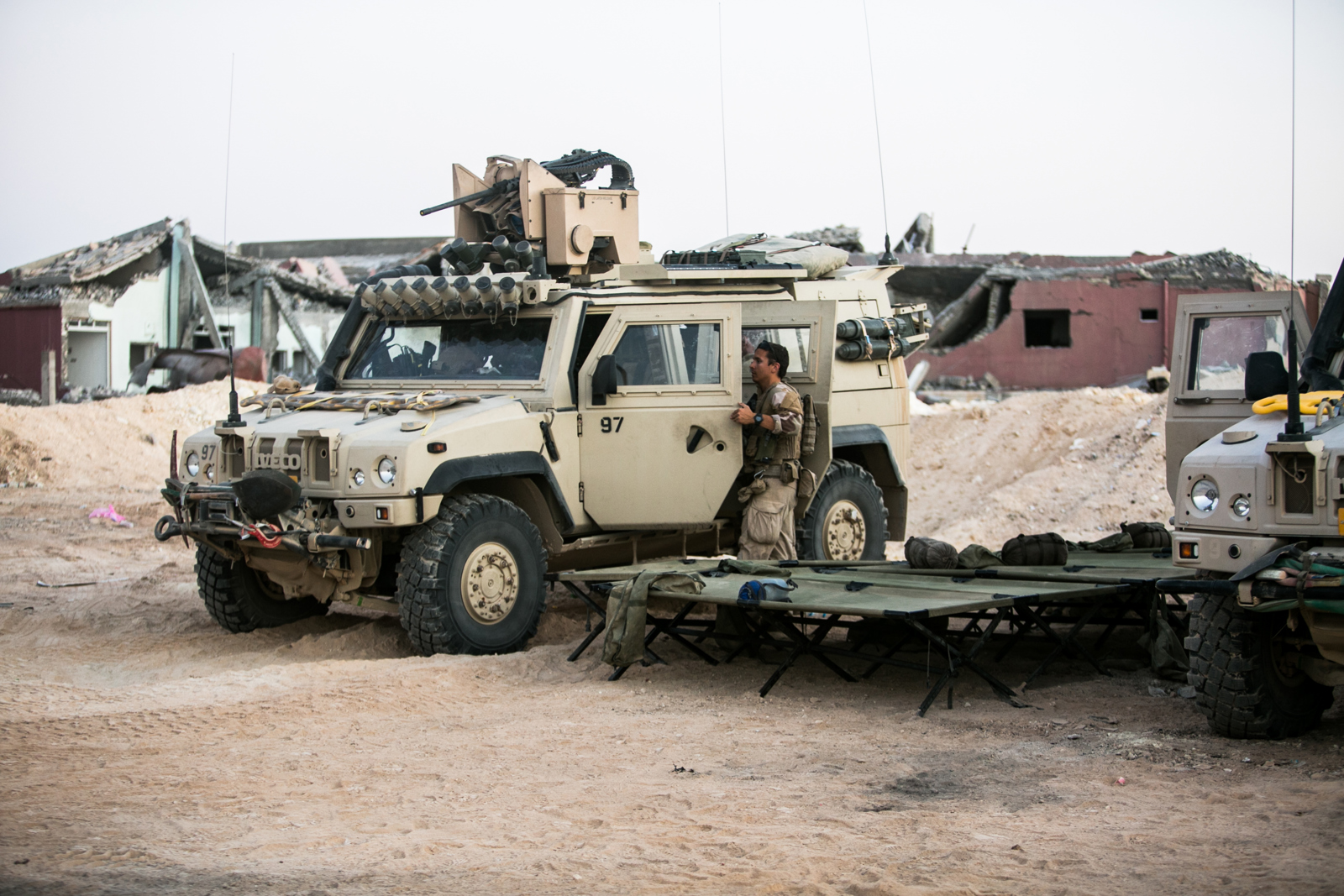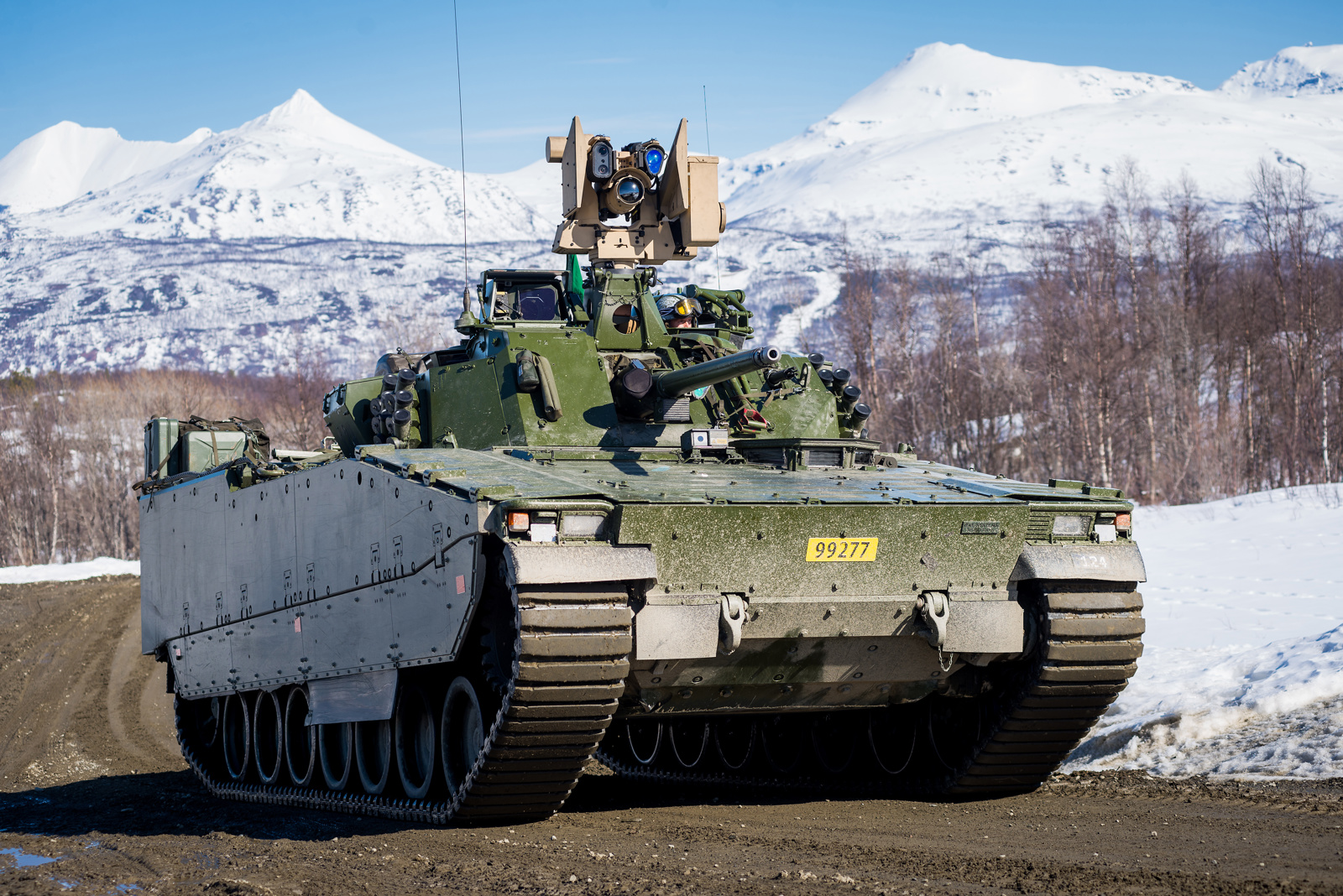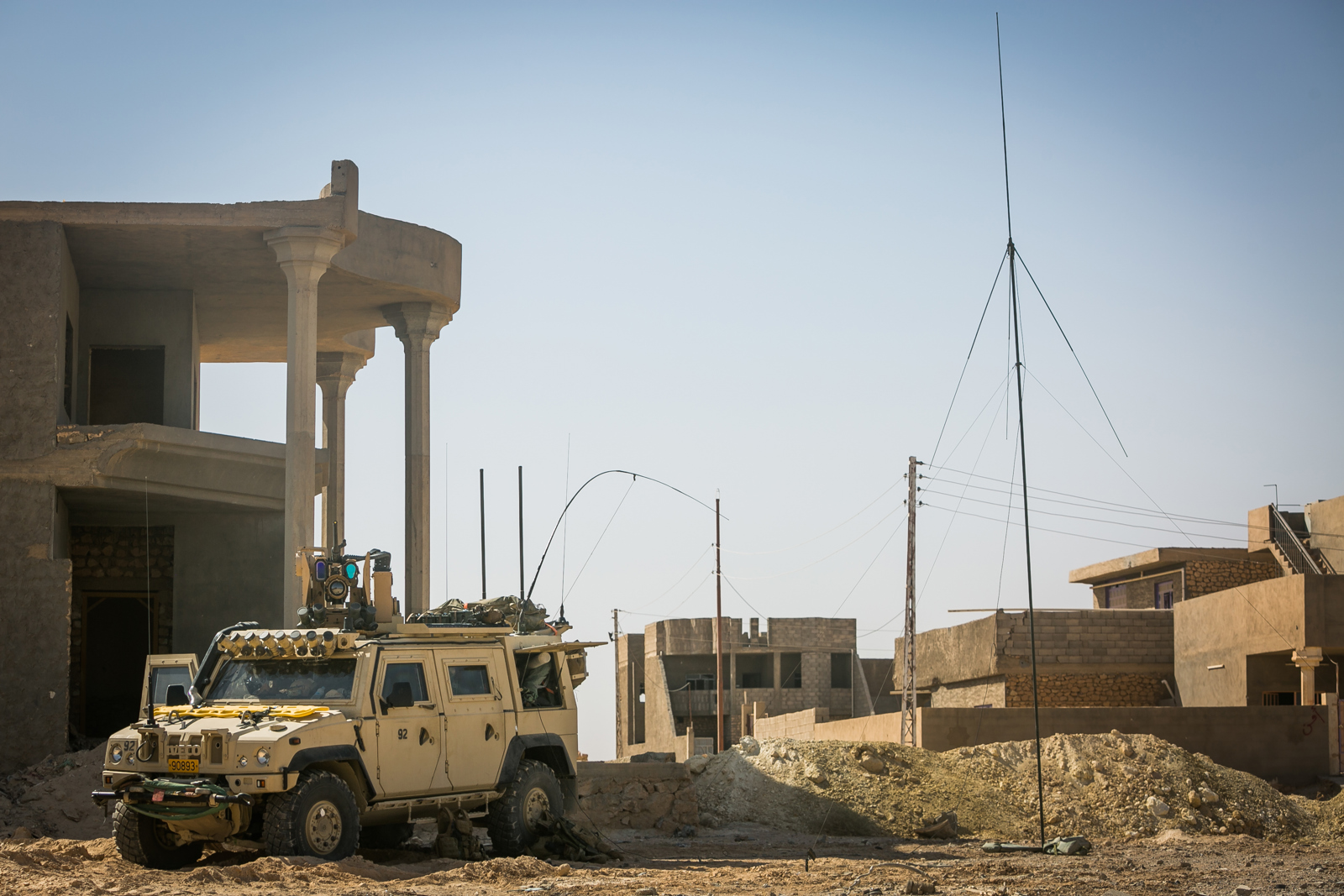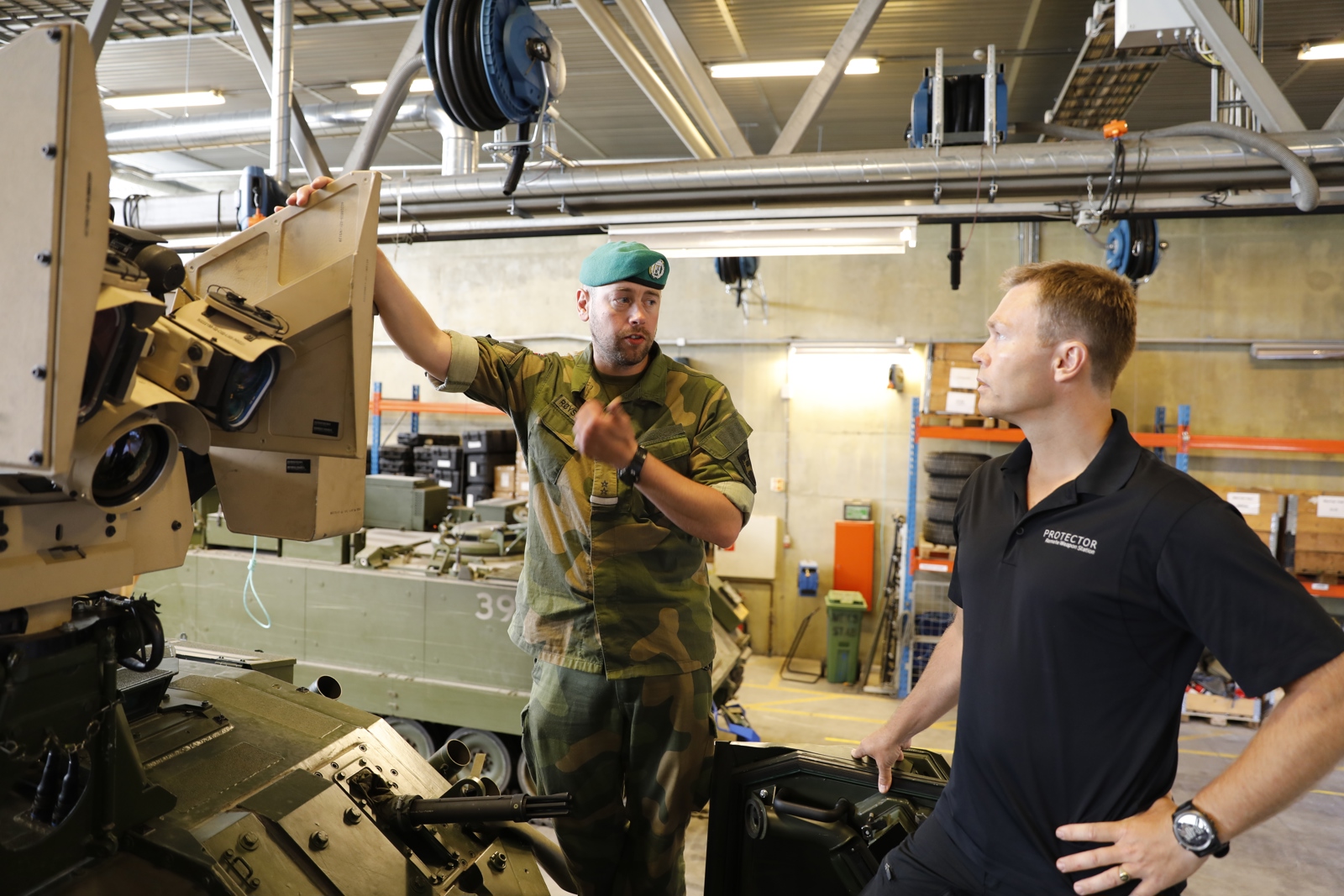
The Remote Weapon Station from KONGSBERG makes soldiers’ lives safer.
-
Text:OVE RONNY HARALDSEN
Photo:CAMILLA BREVIK, TORBJØRN KJOSVOLD - FORSVARET
-
Ove Ronny HaraldsenGroup Communication Manager
To find the origins of the KONGSBERG weapon station as we know it today, we have to go back 20 years. The Norwegian Air Force needed a system capable of destroying mines at airports, while also protecting the gunner inside the vehicle.
The task of developing the system was given to the Defence Research Establishment, which led the construction of the first prototypes.
“One of the requirements was to have an internal ammunition feed, so the system became a 450-kilo colossus, as reinforced steel was needed around and on top of the vehicle. This station was called NM 221, and we delivered a total of 32 stations in collaboration with Vinghøg,” recalls Rune Werner from Kongsberg Defence & Airspace, who has been involved in selling the weapon station since its inception.
The Armed Forces soon discovered that this weapon system could also be used to protect soldiers. The weapon station was widely used by Norwegian soldiers in Kosovo in 1999. The system caused quite a stir within the multinational KFOR forces.

“The Americans had seen the Norwegian systems in Kosovo, and invited us to make a bid. That put us in a position which ended with a great breakthrough for the weapon station. We managed to demonstrate that we had a working system, and in 2001 we won a framework agreement for the delivery of 1,734 units to the US Army,” says Rune Werner.
A STRONG GROWTH
Since its international breakthrough in 2001, around 20,000 units of the weapon station have been sold to 19 countries, making KONGSBERG the world-leading provider of remote weapon stations. By far the greatest user of the system is the US Army, which has around 15,000 weapon stations.
In 2007 KONGSBERG won the CROWS II contract. This was a framework agreement of NOK 8 billion, which in 2009 was expanded by almost NOK 2 billion, corresponding to more than 10 000 remote weapon stations.
In September 2018 KONGSBERG was awarded its third framework agreement with US. Army.

“KONGSBERG is proud to be selected for the next phase of CROWS. We look forward to a continued relationship with the U.S. Army, and the opportunity to support the program office and all the customers and users served by this contract,” says Eirik Lie, President of Kongsberg Defence & Aerospace.
Pål Bratlie, Executive Vice President of Protech Systems, Kongsberg Defence &Aerospace adds.
“This contract award further validates the trust and confidence that the U.S. Army has imparted on KONGSBERG in its nearly two-decade long relationship. This investment will pay great dividends to extend and expand the Army’s CROWS (and RWS) fleet and allow them to continue leveraging their Technical Data Package (TDP).”
All CROWS and RWS systems are produced in the KONGSBERG Johnstown, PA facility. Execution of this contract will secure 3,000 + jobs, both directly and through the KONGSBERG U.S. supply chain.
INCREASED PRECISION, RANGE AND SAFETY
In Norway, a version of the weapon station adapted to Nordic conditions is used, and it has become an important weapon and sensor platform on the Army’s upgraded CV-90 Infantry Fighting Vehicles.
The gunner, the commander and an operator can all control the weapon station. Furthermore, the weapon station can be used as a sensor for the vehicles’ main weapon: a 30 mm canon. The weapon station also has a greater angle of elevation than the main weapon, which is advantageous in urban environments.

“As you master the system, you discover that you can do your job more effectively and become better protected,” says Lieutenant Eivind Røysland of the Telemark battalion. He continues:
“When you are taking fire, you really appreciate being on the inside of the vehicle. You can be a lot more efficient in your job when you feel relatively safe.”
- What effect has the PROTECTOR had on shooting accuracy?
“We can engage the enemy from a greater distance, and this gives us an advantage. We increase our reach from 500 metres to 1,000 metres. That improves our odds.”
OBSERVATION PLATFORM
The soldiers of the Telemark battalion put a particular emphasis on the optical system, which makes the weapon station a particularly good observation platform, both during the day and at night.
When the battalion was stationed in Iraq, supporting Iraqi forces in the fight against the terror organization ISIS, the weapon station was used for surveillance purposes, both when the section was stationary and on the move. Lance Corporal Kaj says:
“In Iraq, we used the system a lot to identify things. Does this look suspicious? Is it as suspicious as it seems to my eyes? You can zoom in and see details. For example, is this vehicle heavily loaded?”
Kaj continues by saying that the weapon station provides extra security when the section is camping out in the desert at night.
“We used the thermal camera at night, which was extremely reassuring as we could then see everything around us. We could immediately identify the tiniest heat source in the flat desert. During the day, the air could be extremely dusty. We then found that we could see better with the thermal camera than with the daytime camera.”

Rasmus, a tank commander with the Telemark battalion, says that the weapon station has largely replaced the use of binoculars.
“When we are in position, we can keep the body of the vehicle protected by the terrain, with only the weapon station exposed over the edge. That puts us in a position to be able to observe and engage with soft targets without having to move the whole vehicle, which we used to do,” says Rasmus, a senior sergeant.
We ask how the weapon station works in winter operations in northern Norway, with the snow, ice and cold. Rasmus and Kaj find a mobile phone picture of a snowed-in tank somewhere in Troms county.
The lenses on the weapon station are clear and free of snow and ice. The lens on the PROTECTOR Nordic contains heating wires, and is in general suited to the tough winter conditions in Norway and Sweden, they say.
MANY VARIANTS
The PROTECTOR Remote Weapon Station from KONGSBERG is currently manufactured in a range of different variants, calibres and configurations. Everything depends on the requirements and wishes of the user.
The smallest systems are for the control of weapons with a calibre of 7.62 mm and below. The PROTECTOR Lite and Super Lite are used for protecting lorries, artillery trucks and smaller vehicles, and can be installed on a tripod and used for guarding and protection.
The PROTECTOR RWS standard model is used for the control of 12.7 mm calibre weapons. These weapon stations can also be equipped with Javelin missiles to engage with armoured targets, as well as small-calibre side weapons or non-lethal equipment such as lights, lasers and sound.
The PROTECTOR RWS is used on both armoured and non-armoured personnel vehicles, as well as on tanks. A low-profile RWS has been developed for the American M1A1 Abrams which does not obstruct the tank commander’s visibility when he is in the turret.




A PROTECTOR RWS Sea has been developed for maritime use, equipped with extra stability in order to be able to hit targets from a boat. This station is suitable for salt-water environments, as some of the components have been replaced with corrosion-free materials.
KONGSBERG has developed the PROTECTOR Medium Caliber Turret for calibres of 30-40 mm. This turret can be used for larger armoured personnel and infantry fighting vehicles. It differs from traditional turret solutions in that the gunner does not rotate with the turret. The turret is controlled in the same way as a weapon station, which saves weight and space on board the tank.
IMPROVING EACH OTHER
Back at Rena, Eivind Røyseland gives us a tour of the Telemark battalion maintenance hall. Gard Brandsæter from Kongsberg Defence & Aerospace and Røyseland climb onto one of the CV90s and discuss a number of aspects of using the weapon station. Brandsæter has 14 years of service in the Armed Forces himself, and the understanding between customer and supplier appears to be excellent.
“I’d characterise the collaboration between us and KONGSBERG as very good,” Røysland says. “We mutually benefit each other, mainly because we are quite a demanding customer. In many cases, we’ve pushed KONGSBERG into making an even better product.”
The vehicle project involved extremely complex integration work for KONGSBERG. The weapon station had to be stabilised at the top of the rotating turret, and integrated with the vehicles combat system.
One of the requirements was that the weapon system should act as a sighting tool for the main weapon, and that sensor data could be shared between other combat vehicles.

“Needing to take full advantage of the combat vehicles capacities, we had to follow the requirements we drew up. We got a good product, and you got a better product, which makes it even better for other customers,” says Røysland.
Røysland sees KONGSBERG as a company willing to listen to the needs of its users, and which takes feedback on board in order to further develop the PROTECTOR weapon system.
“I’ve personally attended a number of user conferences held by KONGSBERG. You can meet users from a number of countries and get the chance to discuss and exchange your experiences with the system. I see KONGSBERG as a company with a lot of time for discussion and input, and this is of mutual benefit to us,” says Lieutenant Eivind Røysland of the Telemark battalion.


